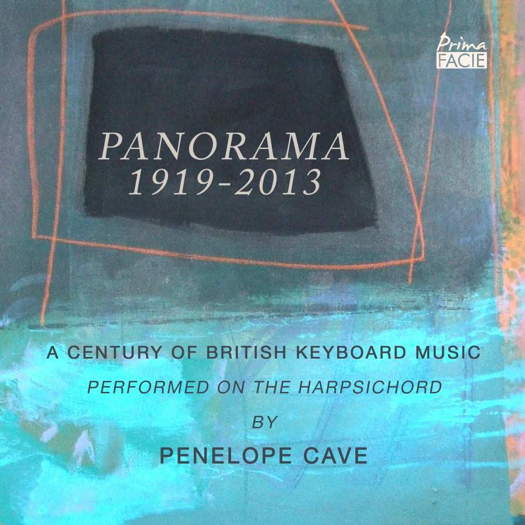- anonymous
- Dag Wirén
- Music and paintings
- Tauno Marttinen
- Larry Adler
- Howells: Psalm Preludes
- Schindler's List
- Orson Welles

A Roman Pietas
GIUSEPPE PENNISI listens to
Petrassi and Shostakovich in Rome
Petrassi and Shostakovich in Rome
On 1 March 2018, I attended an orchestral concert in the huge main hall of the Rome Auditorium: the Santa Cecilia Hall. It hosts an audience of three thousand. This was the second performance of the same program. The hall was not as full as usual, even though Colombian-born and Austrian-naturalized conductor Andrés Orozco-Estrada is quite well-known and well-appreciated in Italy. The empty rows appeared to belong mostly to regular subscribers. On the other hand, there were unfamiliar faces. I concluded that a change in audience type is taking place. This means that the National Santa Cecilia Academy's new management's plan is having an impact: to continue with only eighteenth and nineteenth century music would mean pleasing an ageing and eventually disappearing audience. Meanwhile, it takes time to acquaint listeners with more 'modern' music. This cost is worth paying.
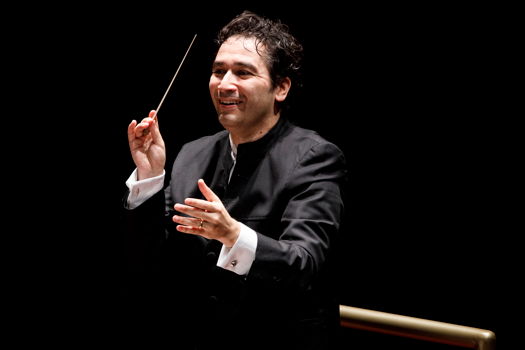
Andrés Orozco-Estrada conducting in Rome. Photo © 2019 Musacchio, Ianniello and Pasqualini
That evening, a Friday night, the program included two mid-nineteenth century compositions: Noche Oscura by Goffredo Petrassi (composed 1950-51) and Symphony No 7 in C, Op 60, Leningrad (1941), by Dmitri Shostakovich. Petrassi's Noche Oscura is virtually unknown - the last performance was in 1994.
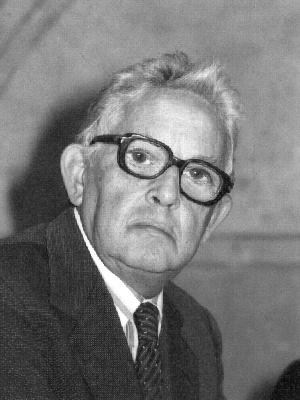
Goffredo Petrassi (1904-2003)
Shostakovich's Leningrad Symphony has been played several times in the concert series of the Accademia Nazionale di Santa Cecilia: in 1998 and 2006 with Valery Gergiev in the pit and in 2010 under the baton of Kirill Petrenko. I wrote a review of the 2010 concert on 10 November 2010 - What does this Symphony mean? The Orchestra Sinfonica Romana also performed this symphony under the baton of Francesco La Vecchia in a multimedia program in May 2013: while the orchestra was playing, 3-D projections of the Leningrad Siege were cast on three screens. No doubt, Shostakovich's Leningrad Symphony attracted most of the audience.
The two parts were very different, although composed almost in the same period. Petrassi's piece is a twenty minute, mostly atonal choral and orchestral composition.
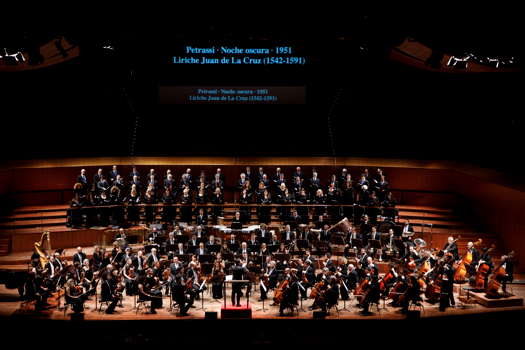
Andrés Orozco-Estrada and the orchestra and choir of the Accademia Nazionale di Santa Cecilia performing Petrassi's Noche Oscura. Photo © 2019 Musacchio, Ianniello and Pasqualini
Shostakovich's work is a large symphony, lasting nearly one hour and twenty minutes, very tonal and with a lot of rhythm as well as melodic parts. The former is 'music of the spirit' dealing with the soul ascending to heaven; it is based on a poem by the Spanish priest and theologian San Juan de la Cruz. The latter deals with the siege of Leningrad, the composer's birthplace and beloved town.
It is useful to recall that the siege of the city lasted nine hundred days between September 1941 and February 1943. Nearly 630,000 people died of hunger and cold, or in the shelling of constant air raids. Shostakovich volunteered to serve, as a fireman, in the defense of the city until, like many other artists, he was evacuated first to Moscow then to Kuibyshev.
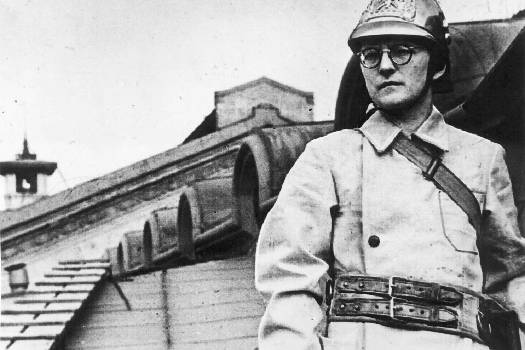
Dmitri Shostakovich (1906-1975) serving in the Leningrad Fire Brigade in 1941
There the symphony was completed and had its first performance on 5 March 1942 by the evacuated Bolshoi Orchestra under Samuel Samosud; the Moscow premiere followed on 29 March and, in the besieged Leningrad, the symphony was played on 9 August. Thereafter, it was played all over the Soviet Union. Briefly, this grand symphony (with over a hundred musicians in the pit) became a symbol of resistance to Nazism and to its siege of one of the most beautiful and historically important towns of European Russia.
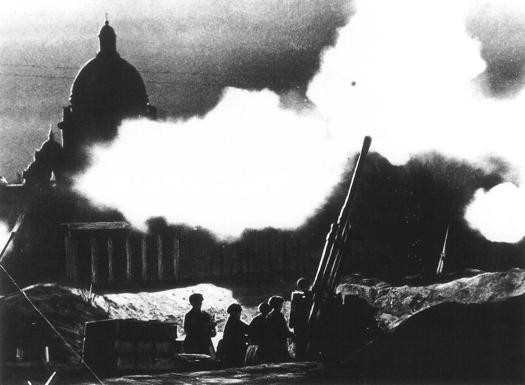
Anti-aircraft gun fire during the siege of Leningrad in 1941
Andrés Orozco-Estrada provided an important link between the two parts of the concert: their theme is Pietas, pity for those dying regardless of their nationality. Pity is at the basis of Petrassi's piece as well as of Shostakovich's immense symphony.
Initially, in Leningrad, each of the four movements had a title: The War, The Recollection, The Fatherland and The Victory. Nonetheless, these titles hardly match the musical content, for example the themes, tonalities, tempos, rhythm and harmony, as clearly shown by Orozco-Estrada. In the first movement, Allegretto, emphasis is not on the fighting bursting into Leningrad's peaceful summer time, but the variation on a musical theme from an operetta - a recollection of Franz Lehar's The Merry Widow, with a crescendo like in Ravel's Bolero.
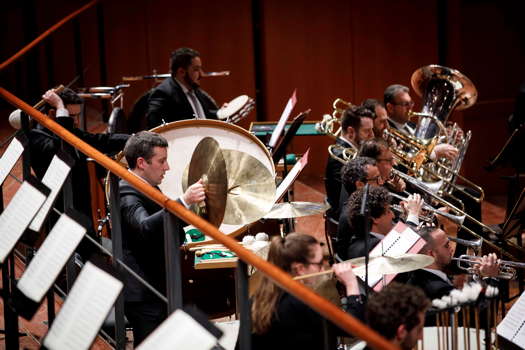
Members of the percussion and brass departments of the Orchestra dell'Accademia Nazionale di Santa Cecilia peforming Shostakovich's Leningrad Symphony. Photo © 2019 Musacchio, Ianniello and Pasqualini
In the second and third movements, respectively, a Moderato (poco allegretto) and an Adagio, the stress is on a Mahler-like melancholy; they are both designed like a rondo; there are dark clouds and painful echoes, but, in spite of the program notes provided in the 1940s and in the 1960s, there is no sense of heroism. In the last movement, Allegro ma non troppo, the audience feels Shostakovich's technical skills in developing a theme as a unifying element for the entire symphony. It is not an emphatic and rhetorical theme, as Soviet intelligentsia would have expected in the 1940s, but a series of harmonic and rhythmic variations around the first movement's leitmotif until its final solemn explosion in the finale. In short, Orozo-Estrada's conducting had many points in common with that of Petrenko in 2010 and was quite different from Gergiev's fiery and heroic accounts in 1998 and 2006.
In my 2010 review, I recalled that several years after Stalin's death, Shostakovich, who had suffered discrimination and isolation during Stalinism, revealed that the symphony had been planned before the war, and hence, before Leningrad's siege, by reading David's Psalms, in particular Psalm 94 about a God who 'shall recompense and destroy'. Shostakovich said also that in Leningrad, before World War II, each family had lost at least a dear one - those who had disappeared during the Stalinist terror - and that his music was in their memory too.
Shostakovich was not a religious man; he was a 'good red-blooded Marxist' with a materialistic view of the universe, no feeling for the after-life, but had a strong sense of piety, a classical piety without any supernatural after-life (ie without any God Almighty) - a Roman Pietas.
The audience applauded Noche Oscura and was enthusiastic about the Leningrad Symphony.
Rome, Italy



